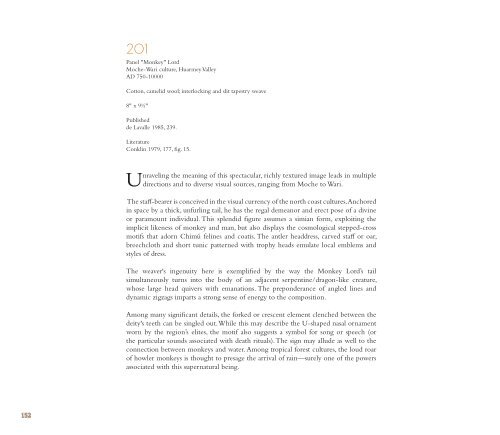You also want an ePaper? Increase the reach of your titles
YUMPU automatically turns print PDFs into web optimized ePapers that Google loves.
201<br />
Panel "Monkey" Lord<br />
Moche-Wari culture, Huarmey Valley<br />
AD 750-10000<br />
Cotton, camelid wool; interlocking and slit tapestry weave<br />
8" x 9½"<br />
Published<br />
de Lavalle 1985, 239.<br />
Literature<br />
Conklin 1979, 177, fig. 15.<br />
Unraveling <strong>the</strong> meaning of this spectacular, richly textured image leads in multiple<br />
directions and to diverse visual sources, ranging from Moche to Wari.<br />
The staff-bearer is conceived in <strong>the</strong> visual currency of <strong>the</strong> north coast cultures. Anchored<br />
in space by a thick, unfurling tail, he has <strong>the</strong> regal demeanor and erect pose of a divine<br />
or paramount individual. This splendid figure assumes a simian form, exploiting <strong>the</strong><br />
implicit likeness of monkey and man, but also displays <strong>the</strong> cosmological stepped-cross<br />
motifs that adorn Chimú felines and coatis. The antler headdress, carved staff or oar,<br />
breechcloth and short tunic patterned with trophy heads emulate local emblems and<br />
styles of dress.<br />
The weaver's ingenuity here is exemplified by <strong>the</strong> way <strong>the</strong> Monkey Lord’s tail<br />
simultaneously turns into <strong>the</strong> body of an adjacent serpentine/dragon-like creature,<br />
whose large head quivers with emanations. The preponderance of angled lines and<br />
dynamic zigzags imparts a strong sense of energy to <strong>the</strong> composition.<br />
Among many significant details, <strong>the</strong> forked or crescent element clenched between <strong>the</strong><br />
deity's teeth can be singled out. While this may describe <strong>the</strong> U-shaped nasal ornament<br />
worn by <strong>the</strong> region’s elites, <strong>the</strong> motif also suggests a symbol for song or speech (or<br />
<strong>the</strong> particular sounds associated with death rituals). The sign may allude as well to <strong>the</strong><br />
connection between monkeys and water. Among tropical forest cultures, <strong>the</strong> loud roar<br />
of howler monkeys is thought to presage <strong>the</strong> arrival of rain—surely one of <strong>the</strong> powers<br />
associated with this supernatural being.<br />
152







